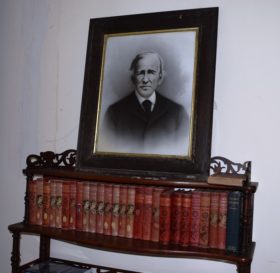Selected works . . .
The Ark of Elm Island (1897)
Arthur Brown, the Young Captain (1870
The Boy Farmers of Elm Island (1869)
Brought to the Front, or, The Young Defenders (1876)
Burying the Hatchet: or, The Young Brave of the Delawares (1878)
Charlie Bell: the Waif of Elm Island (1869)
The Child of the Island Glen (1872)
The Cruise of the Casco (1872)
The Fisher Boys of Pleasant Cove. (1874)
Forest Glen: or, The Mohawk’s Friendship (1877)
Good Old Times: or, Grandfather’s Struggles for a Homestead (1877)
The Hard-scrabble of Elm Island (1898)
John Godsoe’s Legacy (1873)
Lion Ben of Elm Island (1868)
The Live Oak Boys, or, The Adventures of Richard Constable Afloat and Ashore (1882)
The Mission of Black Rifle: or, On the Trail (1876)
Norman Cline (1869)
The Child of the Island Glen (1872)
The Sophomores of Radcliffe , or, James Trafton and his Bosom Friends (1871)
Sowed by the Wind: or, The Poor Boy’s Fortune (1874)
The Spark of Genius or, The College Life of James Trafton (1899)
A Stout Heart, or, The Student from Over the Sea (1873)
A Strong Arm and a Mother’s Blessing (1880)
The Turning of the Tide, or, Radcliffe Rich and his Patients (1873)
Winning His Spurs, or, Henry Morton’s First Trial (1872)
The Young Deliverers of Pleasant Cove (1899)
The Young Ship-builders of Elm Island (1870)
Elijah Kellogg (1813-1901) was a Congregational clergyman and author, born in Portland on May 20, 1813. The son of Rev. Elijah and Eunice (McLellan) Kellogg, his early boyhood was spent in Portland.
Before entering Bowdoin College in 1836, he had been “indentured” on a farm for one year and then went to sea for three years. While in college, from which he was graduated in 1840, he made friends with the farming and sea-faring folk of the neighboring town of Harpswell and after three years at Andover Theological Seminary, he became pastor of the Congregational church in Harpswell Center, being ordained June 18, 1844.
His devoutness and methods of preaching the Gospel won the affection of his parishioners. He would swim, sail, farm, and fish with the boys in his parish and then, at an unexpected moment, kneel down in their boat, or in the field, and pray with them. Nearby Bowdoin College often sent difficult students to stay with him for a few weeks in hopes of setting them on a constructive path.
From 1855 to 1867 he was pastor of the Mariners’ Church and chaplain of the Sailors’ Home in Boston. For eighteen years thereafter he turned to writing. His “Spartacus to the Gladiators,” was first published in the School Reader in 1846. Later he wrote “Regulus to the Carthaginians,” “Hannibal at the Altar,” and “Pericles to the People.”
His first long tale, Good Old Times, appeared in 1867 in Our Young Folks, and issued in book form in 1878. The story of his great-grandfather’s struggle at the beginning of the eighteenth century to cut a home out of the forest wilderness of Maine, it became popular at once.
After that, the books came thick and fast, so that by 1883 there were twenty-nine in all.
Of these perhaps the best liked are Lion Ben (1869), The Young Ship-Builders of Elm Island (1870) [one of the many “Elm Island” stories], The Sophomores of Radcliffe (1872), The Mission of Black Rifle (1876), and A Strong Arm and a Mother’s Blessing (1881).
His stories deal with the life and adventures of people along the shores of Casco Bay, of Scotch-Irish settlers on the western frontier of Pennsylvania, and of the students of Bowdoin College during or just before his own college days.
His boys are not pirates or savages, neither are they plaster saints. They are courageous country boys, “able to cut their own fodder.” The stories teach the virtues of neighborliness, virility, and fair dealing. While they do not depreciate book-learning, they place a high value upon the ability to do all kinds of manual work. Although the language in which they are told sometimes shows signs of haste and often seems homely, it is quaint and idiomatic, and the tales give unmistakable evidence that the author knew well both the speech and the life of the people about whom he wrote.
In 1885 Kellogg returned to Harpswell, to his old church, and for the rest of his life he preached there or in the neighboring town of Topsham. He died March 17, 1901.
—————
Abridged and edited from “Elijah Kellogg.” Dictionary of American Biography Base Set. American Council of Learned Societies, 1928-1936. Reproduced in Biography Resource Center. Farmington Hills, Mich.: Thomson Gale. 2005. http://galenet.galegroup.com/servlet/BioRC. This source also recommends the following: W. B. Mitchell, Elijah Kellogg: The Man and His Work (1903), giving a complete list of his books and their dates of publication; Timothy Hopkins, The Kelloggs in the Old World and the New (1903), vol. I; Tales of Bowdoin (1901), comp. by J. C. Minot and D. F. Snow; Isabel T. Ray, in New England Mag., June 1902; Daily Eastern Argus (Portland), Mar. 18, 1901; Congregationalist, Mar. 23, 30, 1901.
Additional resources
[Photo from Harpswell Historical Society]
Mitchell, Wilmot Brookings (Ed.). Elijah Kellogg: The Man and his Work: Chapters from His Life and Selections from his Writings. Boston, Mass. Lee and Shepard. 1903.
Ray, Isabel T. Rev. Elijah Kellogg: Author and Preacher. 1902?
Storer, C. A. A. Elijah Kellogg: 19th Century New England Orthodox Preacher. [microform] Thesis (Ph. D.) — Michigan State University, 1969.


